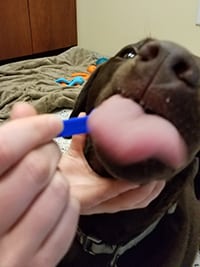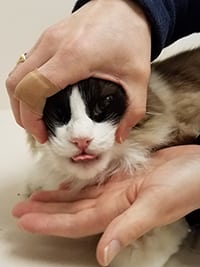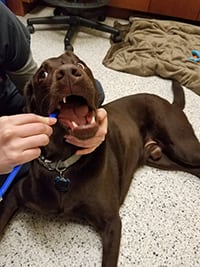1. Take it slow
Cats and dogs can be anxious and fearful of new things, especially when it involves you handling an area of their body they are not used to you handling. More notably they may be more uncertain because you are going in their mouth as opposed to just handling the outsides, which they are likely very used to.

Help Fig 1.
2. Get them used to the brush near their face
Sometimes it’s just the fact that there is something weird near their face that they are objecting to. (Help Fig 1) Touch the brush to their body and show them it’s not scary and as they get used to it, move it closer to their muzzles. What you want to do is get them to be okay with brushing the fur on their muzzles and continue to then work towards the lips. It may take time, so as the first tip says, take it slow.

Help Fig. 2
3. Handle the mouth area frequently
The next time you and your furry companion are having down time together, rub a nose, or around the whiskers, chin scratches are just about always welcome and get them used to your hands all over their face in a positive way. Eventually, work closer to their lips and gently and slightly pick up a part of the lip for a brief moment then let it back down. Increase the time you hold the lip up until your cat or dog, doesn’t think it’s anything strange anymore. (Help Fig 2) For the kitty owners, don’t be surprised if it takes a lot longer than you expect (think months). And don’t forget, keep it positive, if your critter decides he or she has had enough, then let it be enough and don’t force them.
4. Super special treats
A lot of the time a “treat” is a food related item and if there is something that your fur-kids especially enjoy, then only pull it out for after tooth brushing, they will learn pretty quickly that they will get that favorite thing after the brushing is done. Treats though don’t necessarily have to be a food item. You can also use favorite activities, if your dog or cat loves a good brushing, or for the cats, drinking water out of the faucet, or for the dogs, going on a walk or playing with a favorite toy with you. You can use things like that as the reward.
5. Brushing right before a meal
Dogs and cats don’t normally get cavities unless you are feeding them something that has sugar in it, so brushing for them isn’t meal dependent. If you feed them on a schedule, there’s a fair chance your cat or dog has learned to tell time. You can use that to your advantage by brushing right before they get their food so they are anticipating the food after and will be more likely to cooperate in order to get the meal. The idea is similar to getting that very special treat as mentioned previously.

Help Fig. 3 – So much for my nap!
6. Making them comfortable
While you don’t want to sneak attack them when they’re sleeping, you may want to introduce brushing when they are in a comfortable position, whether it’s chilling on the couch with you, snuggled in your lap, or somewhere in the house you find that they are relaxed. You can associate that relaxed time with brushing. Just be careful though, if they are still very afraid of the brush, you don’t want to scare them off from that area they like to be. (Help Fig 3)

Help Fig. 4 – I’ve got a word for you!
7. Word Association
Brushing is just like any other training. If you do something consistently long enough, they will pick up on it. So if you use a particular word (and yes cats can learn words too, the difference between cats and dogs, is they have been scientifically proven to have the ability to ignore you, which you already knew if a cat owns you), they will associate that word with brushing and their reward. It doesn’t really matter what the word is either, just keep it clear and consistent. (Help Fig 4)
If you have more questions about brushing or about their mouth health in general, contact us or set up an appointment if you’re in the area.
